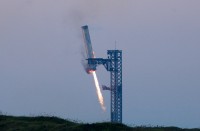China on Tuesday launched its most sophisticated observation satellite, Gaofen-4, as part of the country’s high-definition (HD) earth observation project.
Gaofen-4 was launched from the Xichang Satellite Launch Center in the southwest China province of Sichuan at 00:04 aboard a Long March-3B carrier rocket. It was the 222th flight of the Long March rocket series, according to the State Administration of Science, Technology and Industry for National Defense (SASTIND).
“The rockets has high reliability, high launching density and high orbit injection accuracy,” said Li Hong, president of the Academy of Launch Vehicle Technology, China Aerospace Science and Technology Corporation.
Gaofen-4 is China’s first geosynchronous orbit HD optical imaging satellite and the world’s most sophisticated HD geosynchronous orbit remote sensing satellite.
The successful launch of Gaofen-4 was the 19th space mission in this year. It will be used for disaster prevention and relief, surveillance of geological disasters and forest disasters, and meteorologic forecast.
“This is the final launch of the total 86 rocket launching in the 12th Five Year Plan period (2011-2015). No matter it is in terms of the launching times, chance of success or the launching frequency, China ranks among the world’s top three rocket launches,” said SASTIND Deputy Head Wu Yanhua.
The Gaofen project aims to launch seven high-definition observation satellites before 2020.
Gaofen-1, the first satellite of the project, was launched in April 2013.
Different from Gaofen-1 and Gaofen-2 in low orbits (600-700 km) around the earth, Gaofen-4 is located at the orbit 36,000 kilometers away from the earth and moves synchronously with the earth.
It can “see” an oil tanker on the sea with a huge CMOS camera (Complementary Metal Oxide Semiconductor camera), reaching the best imaging level among global high-orbit remote sensing satellites. (CCTV)








